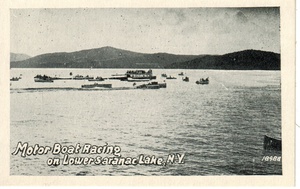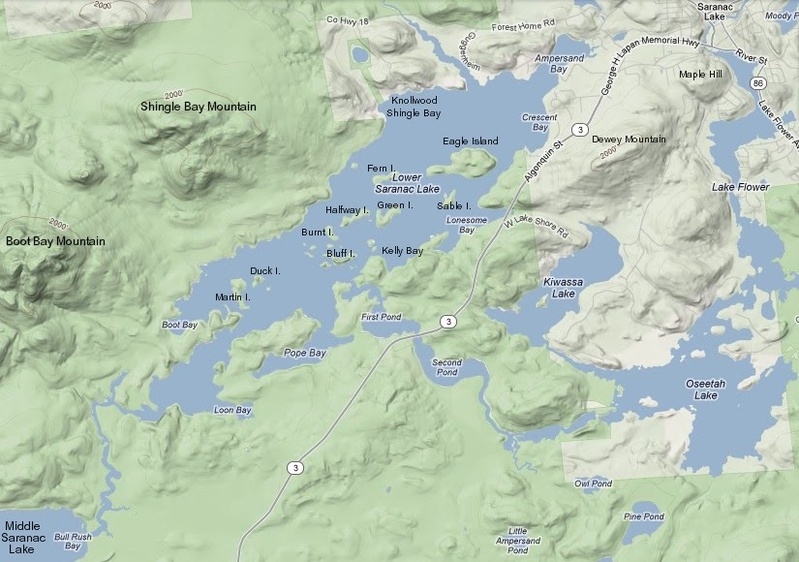 View from a campsite on Lower Saranac Lake
View from a campsite on Lower Saranac Lake
Lower Saranac Lake is one of three connected lakes, part of the Saranac River, near the village of Saranac Lake. With Middle Saranac Lake and Upper Saranac Lake, a 17-mile paddle with only one carry is possible. The Saranac Lake Islands Public Campground provides 87 campsites on inlands in Lower and Middle Saranac Lake. In addition to the Saranac River, it is fed by nearby Lake Colby, Fish Creek, and Lilly Pad Pond.
History
Prior to the development of railroads and the automobile, the Saranac Lakes formed part of an important transportation route in the Adirondacks; one could travel 140 miles across, from Old Forge to Lake Champlain, almost entirely on water. In 1849, William F. Martin built one of the first hotels in the Adirondacks— the "Saranac Lake House", known simply as "Martin's"— on the northeast shore of Lower Saranac Lake. Martin's, with room for 80 guests, became a favorite place for hunters, woodsmen, and socialites to meet and interact; a young Theodore Roosevelt was among the guests, 1 and the members of the famous "Philosopher's Camp" on Follensby Pond (including poets Ralph Waldo Emerson and James Russell Lowell and scientist Louis Agassiz) found their guides at Martins. 2 The publication of W.H.H. Murray's Adventures in the Wilderness; Or Camp-Life in the Adirondacks in 1869, containing a favorable review of Martin's, started a flood of tourists to the area, leading to a rash of hotel building and the development of stage coach lines. In 1892, Dr. William Seward Webb's Mohawk and Malone Railway reached the village of Saranac Lake; it dramatically reduced travel time from major east coast cities to the Adirondacks, and had a major impact on the hotel and the area. In 1870, the hotel's capacity was doubled. In 1880, Martin lost the hotel through foreclosure. The new owner promptly remodeled and increased capacity to 250 guests. In 1888, it underwent its final renovations, but in 1894, it burned to the ground.
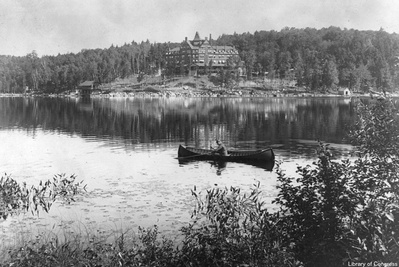 Hotel Ampersand, 1890 (Stoddard) In 1884, a new hotel was built half a mile southeast of Martins. Known originally as Alexander's or the Alexander House, with a capacity for one hundred guests, in 1890, it changed hands and was renamed The Algonquin. It quickly established a reputation for luxury, modern technology, and fine cusine, and the capacity was soon raised to 150. In 1914, the hotel was leased to a firm that tried using it as a tuberculosis sanatorium, an innovation that failed the first year. Although it resumed operation as a hotel, it never did well again, changing hands several times, ultimately becoming the property of Edmond Guggenheim, who owned property nearby; he donated it to the Trudeau Institute, which replaced the structure with their present building in the late 1950s.
Hotel Ampersand, 1890 (Stoddard) In 1884, a new hotel was built half a mile southeast of Martins. Known originally as Alexander's or the Alexander House, with a capacity for one hundred guests, in 1890, it changed hands and was renamed The Algonquin. It quickly established a reputation for luxury, modern technology, and fine cusine, and the capacity was soon raised to 150. In 1914, the hotel was leased to a firm that tried using it as a tuberculosis sanatorium, an innovation that failed the first year. Although it resumed operation as a hotel, it never did well again, changing hands several times, ultimately becoming the property of Edmond Guggenheim, who owned property nearby; he donated it to the Trudeau Institute, which replaced the structure with their present building in the late 1950s.
In 1888, a third hotel was built at the northern end of the lake, this on the western shore of Ampersand bay, the Hotel Ampersand. Originally conceived as a year-round health resort, banking on Saranac Lake's reputation for the treatment of tuberculosis, instead it found its best clientele to be healthy summer vacationers. The largest and most fashionable of the three hotels, it was dubbed the Saratoga of Lower Saranac Lake. It was saved from the slow decline of its neighbors by a spectacular fire in 1907. It was never rebuilt.
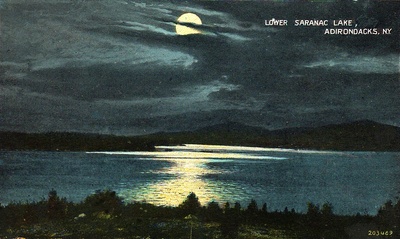 Postcard of Lower Saranac Lake by moonlight.
Postcard of Lower Saranac Lake by moonlight.
It appears to have been taken from the Algonquin Hotel looking west toward Boot Bay Mountain and Shingle Bay Mountain.
As the state owned much of the shoreline of Lower Saranac Lake, there is much less development there than on Upper Saranac Lake. One notable property is the Knollwood Club, built in 1899-1900 by local architect William L. Coulter for six friends, including Louis Marshall, Daniel Guggenheim. Wilderness activist Bob Marshall and conservationist George Marshall spent the summers of their youth there, 3 and Albert Einstein was a frequent summer visitor;4 he was at Knollwood on August 6, 1945 when he heard on the radio that that atom bomb had been dropped on Hiroshima. Einstein enjoyed sailing on the lake, and on occasion needed to be rescued by local residents after capsizing. 56
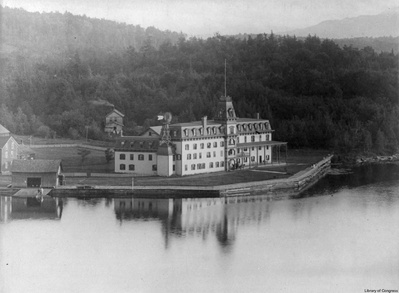 Saranac Lake House, 1890 (Seneca Ray Stoddard)
Saranac Lake House, 1890 (Seneca Ray Stoddard)
Adirondack Daily Enterprise, January 16, 1993
Taking an in-depth look at Lower Saranac Lake
Of the three major bodies of water making up the famous Saranac Chain of Lakes, Lower Saranac, as the name implies, serves as the bottom link of the chain. Being the one nearest to our village in both physical location and local history it is also most closely related to our community's economy.
The lake is five miles long and, in places, a mile wide. It runs in a southwesterly by northeasterly direction at an elevation of 1,533 feet above sea level. The lake is studded with many islands which are state-owned while approximately two-thirds of the shoreline is also state owned with the remaining third, at the eastern end, being privately owned. The two private properties that form the borderline with state lands are Knollwood Club on the north shore and Crescent Bay on the south shore.
 The Algonquin (c. 1900 - 1910)
The Algonquin (c. 1900 - 1910)
Beginning at Knollwood, in a historical clockwise, direction there are several points of interest that existed prior to, and shortly after, the turn of the century. Knollwood Club was built in 1899-1900 as a six-family complex with the original members being Louis Marshall, Daniel Guggenheim, Max Nathan, Elias Ashiel, George Blumental and Abram Stein. They purchased 500 acres of land bordered on the north by Forest Home Road, on the east by Fish Creek, on the south by the lake, and on the west by state land. Each owner had his own camp building while a casino, boat-house, a caretaker's house, and several out-buildings were community-owned and managed. In addition to the caretaker and the main housekeeper each family also had its own guide. Herb Clark was Louis Marshall's choice and, together with two of the Marshall sons, Bob and George, the trio made history by becoming the first to climb all of the 46 major Adirondack peaks. Today the Marshalls are the only remaining generation of the original six members.
Across Fish Creek from Knollwood was the Limburg camp called "Rock Ledge," which was built by Richard Limburg in 1898, a governor of the New York Stock Exchange. When only in his teens, he suffered from tuberculosis and was sent here to take the cure. Enraptured with the area he resolved some day to come back and build a camp. He was friendly with Adolph Lewisohn on Upper Saranac and there were many back-and-forth visits. The Limburg family maintained the camp until World War I and it was later purchased by Edmond Guggenheim, well-known sportsman and local philanthropist. For many years Lower Saranac played host to a boat race regatta and Ed Guggenheim was an avid participant with his inboard speedboat the Miss Saranac.
 Hotel Ampersand, William Henry Jackson, 1902
Hotel Ampersand, William Henry Jackson, 1902
To the east of Rock Ledge for many summers the Haase family occupied Pinehurst Camp with a lengthy shorefront extending from Rock Ledge well into Ampersand Bay. At the very tip of the bay was the Ampersand Hotel, an extravagant structure that could accommodate 300 guests. Operated by Charles Easton, the hotel made a rare attempt at staying open during the winter months with a toboggan slide, skating parties, and sulky races on the ice, but the effort didn't pay off. The summer activities proved more successful, with a nine-hole golf course, a baseball team, and weekly concerts to keep the tourists coming. Seaver Miller, editor of the Adirondack News, kept the public informed of the card games, billiard matches, plays, and recitals that were taking place at the hotel.
On the night of Sept, 23rd, 1907 the Ampersand Hotel went up in flames. A decline in business led to the suspicion that perhaps arson might have caused the fire. Litigation between the owners and the insurance company continued for seven years prior to being settled in 1914 with a payment of $100,000. In 1920 Charles Eaton sold the remainder of the property to Sam Matthews.
Continuing clockwise along the southeast shore there were no buildings between the Ampersand and Martin's Hotel, which was at the foot of Lake Street. Martin's was the oldest structure on the lake, being built in 1851 by William F. Martin, and the place soon gained prominence as one of the best-known Adirondack resorts in local history. Among the clientele were famous persons from all walks of life. The registers listed presidents, vice presidents, governors, captains of industry, writers, artists, and all of their favorite guides. At its peak the hotel could house 300 guests in 250 rooms and boasted bowling alleys, billiard room, and a huge verandah fronting on a lakeside croquet lawn.
In 1881 the hotel was purchased by Milo B. Miller and seven years later it burned to the ground.
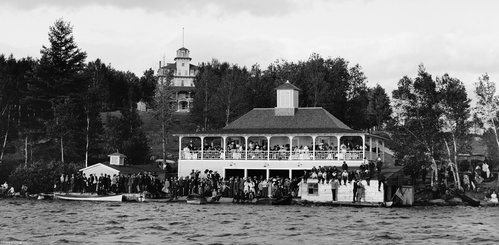 Regatta day at the Algonquin, c. 1909. Courtesy of the Library of Congress. Notice the early horseless carriages at lower right. Click on this photo to see amazing detail!
Regatta day at the Algonquin, c. 1909. Courtesy of the Library of Congress. Notice the early horseless carriages at lower right. Click on this photo to see amazing detail!
Continuing along the southern shore there were many private camps between the Martin Hotel and the Algonquin Hotel. Among the better known were such names as Williams, Hyde, Harris, Kane, McMartin, and Hanes. The Algonquin was built in 1844 by Jabez Alexander but for most of the hotel's existence it was owned and operated by John Harding. Situated at the end of the avenue which bears its name, the Algonquin sat high above the lake with a splendid view toward Eagle Island and Boot Bay Mountain. Harding gained his hotel experience under the tutelage of Paul Smith and was very successful in his own right. His popularity at the Algonquin led to his being elected to the offices of town superintendent and Saranac Lake village president. He also built the Harding Block at the corner of Main and Academy streets.
Like so many other Adirondack resort hotels the Algonquin began to fall upon lean times. In 1920 Harding sold the property to William N. Hanes of Winston-Salem, N.C. and it never operated as a hotel again. The boathouse remained in business under a lease to Burt Alvord who, together with his son, Earl, ran the place as a boat livery for many years. Eventually both the hotel and the boat-house were torn down and the property was purchased by Ed Guggenheim, who later donated it to the Trudeau Institute.
West of the Algonquin was the Steele Camp, which was owned by Mr. and Mrs. Robert Steele of Philadelphia. In the summer of 1926 the camp was rented to Ambassador Baron Nobile Giacoma De Martino, Italy's envoy to the United States during Mussolini's term of power. Prior to his stay village and town employees were hastily summoned to remove the bumps and fill the potholes along Algonquin Ave. so that the ambassador would enjoy a smooth introduction to his summer residence.
The next camp belonged to Charles J. Swain, who was Steele's brother-in-law and an active participant in both summer and winter sports. He raced his boat in the Lower Lake regattas and had a special propeller-driven sled built so that he could drive it on the lake's ice in the winter. 7
Just beyond Swain's camp we arrive at Crescent Bay, which is the western terminal of private land on the south shore. Harry Duso built his marina here in a very advantageous location to serve the boating public with access to the lake.
The earlier mentioned two-thirds of the lake, and all of the islands which were, and, of course, still are, owned by the state for many years, were open to public use through a very popular program known as the platform permit system. This allowed recipients to erect a tent on an approved type of platform on state land after acquiring a permit from the Conservation Department. Because of the proximity of the village to Lower Saranac Lake a preponderance of the permit holders were members of our community. Families could easily reach camp after work or on weekends to escape the summer heat.
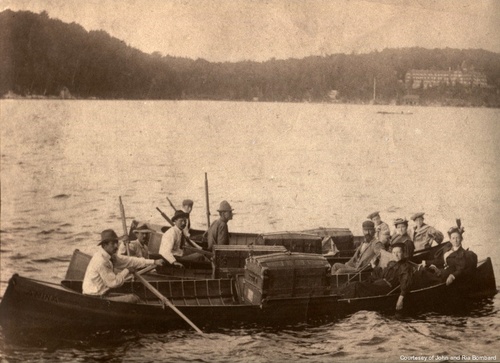 Guests and their trunks, arriving or departing. Hotel Ampersand in the background
Guests and their trunks, arriving or departing. Hotel Ampersand in the background
These highly valued permits were enjoyed by three generations of campers until the privilege was revoked in 1972. A ruling filtered down from Governor Rockefeller to rescind all such permits and the beloved camps were ordered to be removed from state lands. A Tent Platform Association was formed by local residents to counter the mandate with the claim that the permits should be valid. It was stated that the program had been approved by the Conservation Department in 1916 and should remain in force as granted. On March 27th, 1972 the group argued its case before the APA with strong convictions, but all in vain. The APA ruling stated that such permits were in violation of Section 7, Article VII of the New York State Constitution (the forever wild clause) as enacted in 1894. So ended the camp colony.
Historically the lake has received many famous visitors attracted by the area's beauty or, as in some cases, by the area's reputation in the field of health restoration.
During the 1930s Albert Einstein was a frequent guest of Knollwood Club and much earlier noted individuals came for the sheer joy of camping, hunting, and fishing. Artists A.F. Tait and W.J. Stillman came to paint and Teddy Roosevelt came for the sporting activities. Robert Louis Stevenson came to the Lower Lake in the fall of 1887 to visit with the Ehriches family at Pinehurst prior to the Haase occupation. On the opposite side of the lake Mark Twain spent the summer of 1901 at the Kane camp and much earlier, in 1858, two other accomplished writers, Ralph Waldo Emerson and James Russell Lowell, stayed at Martin's with their friend, Louis Agassiz.
Over the years many new camps have been built along the lake shore throughout the private sector. Knollwood is still Knollwood but Rock Ledge became the property of the Catholic Church, where both youth and adult programs offer seminars that feature summer fun. Pinehurst has been subdivided, allowing several families to enjoy the lake's attractions. On the former site of the Algonquin the prestigious Trudeau Institute now faces out toward Eagle Island but those old familiar tent platforms are gone from the scene forever.
 "A Boathouse on Lower Saranac Lake
"A Boathouse on Lower Saranac Lake
From a photograph by Woodward, Plattsburgh,"
Unidentified news clipping, c. 1900, from "Scrapbook No. 1," Saranac Lake Free Library
New York Times, July 5, 1896
UP IN THE ADIRONDACKS.
Many New Yorkers Are There Catching Fish.
Saranac Lake, July 4.—A genuine surprise awaits those who come to the Adirondack Mountains and to Saranac Lake for the first time—a surprise which soon ripens into affection for the places which give them health, rest, and recreation.
If any person doubts the growing popularity of the Adirondacks as a resort for the tourist and sportsman, as well as for the health-seeking invalid, he need take but a single trip among the cottages and camps which line the shores of Lakes Placid and Mirror, the Saranacs and the St. Regis, to be convinced that it is a reality, and not a delusion. Thousands of dollars have been expended this Spring in beautifying these elegant Summer homes which are modestly called " camps," the most of which are now in readiness for their owners. An unusually large number of distinguished people has entered the woods during the past week, and many others are expected here immediately after the Fourth. Several new tents have recently been put up in the Ampersand Grove, and this little "white city" has all its homes occupied with gay and merry people. The Rev. Walter H. Larom's new cottage for the entertainment of Episcopal clergymen is rapidly nearing completion, and will be ready for occupancy soon.
Mrs. C. W. Rockwood of New-York charms the guests of the Hotel Ampersand with her sweet and cultured voice, J. Howard Demarest, G. H. Newman, and W. H. Duff, all from New-York, are successful fishermen, and bring in fine strings of brook trout almost daily. John Seeley Ward of New-York, who is making a. tour of the Adirondacks, was at the Ampersand during Sunday. S. B. Ferris, Miss Ferris, and Miss A. E. Ferris of Lakewood, N. J., spend a few days at this hotel before going into their camp on Deer Island in the centre of the Upper Saranac Lake. Among the latest names appearing on the register are those of Mr. John Kellogg and family, Mr. and Mrs. N. Gilford, George J. Clark, Jr., F. E. Eddy and family, J. M. Dodd and family, W. H. Boland, Edgar Freeman, D. W. Sears, W. W. McCormick, F. W. Strong, Mr. and Mrs. Alfred Tucker. Mr. and Mrs. Eli K. Robinson, Mr. and Mrs. George H. Byrd. Miss Lucy Byrd, W. G. Demarest, and Benson Bennett Sloan, all from NewYork; John L. Van Varkenburgh, Albany; Mr. and Mrs. Mitchell, Cincinnati, Ohio. Dr. and Mrs. Trudeau and .family have been staying at this hotel since its doors were first thrown open for the season of 1890 but will go to Paul Smith's to occupy the elegant new cottage recently built for them there, during the present week- Mr. "Ned" Trudeau, Yale's famous pitcher, will start the ball rolling, and revive the interest in the National game…
New York Evening Post, July 14, 1900
CAMP BUILDING IN THE ADIRONDACKS
Great Activity This Season—Some Big Camps Described.
A glance at Saranac Lake and its surrounding country as it was ten or more years ago and as it is today reveals many changes, but in nothing perhaps is this more apparent than in its camps and cottages. Ten years ago a rude lean-to, a few tents roughly furnished, and a big, open fireplace were all the tourist required. 'The -visitor came for an out-of-door life devoted mostly to hunting and fishing, and the simplest dress was the invariable costume for both sexes. With the increased number of visitors who come here each year, and with the many other changes which have taken place, a gradual change in the mode of living has come about, until today the Adirondack resorts approach Newport in "style” of modern architecture have succeeded the rustic camp.
The number of private camps and cottages building this season is unprecedented, and Adirondack real estate is selling at a higher figure than ever before. In every part of the wilderness where people have been wont to stop in search of either health or pleasure, unusual preparations have been in progress for the reception and entertainment of guests. Architects and builders have kept an army of workmen busy for the past four months, and are now seeking in vain for more carpenters. One New York city architect has drawn plans for, buildings to cost more than $600,000 during the past three seasons.
Real estate in the vicinity of the Saranacs is more valuable than Adirondack land in general for a number of reasons. In the first place, the country hereabout is extremely picturesque. Perhaps nowhere in the wilderness can more extended and beautiful views be obtained than here, embracing, too, a number of noted peaks. On the shores of the Saranacs are some of the great hotels which have helped to attract so many visitors. The shores surrounding these lakes are heavily timbered with spruce, pine, hemlock birch, beech and maple. The woods are filled with streams rushing along on their way to the lakes, and each of these streams contains trout, while game may still be found, in season, in the forest.
Perhaps of all the territory surrounding the three Saranac lakes, none is held at so high a price as that about the Lower Saranac. This lake contains fifty-three islands, many deep bays, and unsurpassed shores for camping-grounds. Besides the hotels, there are the Ehrich property, upon which has been expended more than $50,000; the Swaine cottage, which cost its original owner, Mr. Dunning, of New York, $80,000; the Manierre camp in Shingle Bay, and the Straus property, on the west side of the lake. A few months ago a party of six New York capitalists purchased of Mr. Straus 350 acres along the Lower Saranac, and are now erecting cottages the total cost of which will reach $1,000,000. The place is called "Camp Knollwood,” and is owned by George Blumenthal, E. Asiel, Max Nathan, Louis Marshall, David Guggenheim, and A. N. Stein.
For the rest of the article, see Knollwood Club, Camp Pinebrook, Bull Point Camp and Bay Pond.
New York Times , August 4, 1907
Fishing and Motor Boating on the Lakes the Principal Occupations for Adirondack Pleasure Seekers
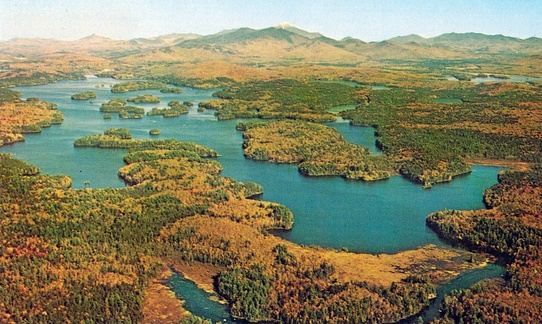 An aerial view of Lower Saranac Lake from the south. The Saranac River enters at lower right, and exits to the right a bit above the center, leading to Lakes Kiwassa and Oseetah. Boot Bay is at left center, with Shingle Bay above it. Ampersand Bay is at top left. Whiteface Mountain is the snow-covered peak with McKenzie Mountain in front of it to the left, and Moose Mountain still further left. Postcard courtesy of Noreen Oslander…On or near Ampersand Bay are cottages occupied by J. W. Limberger, a member of the New York Stock Exchange, and his family. The home is called Rockledge," and has its own fine garden adjunct. The Morgenthau cottage, almost adjoining "Rockledge," is occupied this year by Mrs. Sherman of New York. Floyd Jones and family of New York have gone in for motor-boating this year and created considerable rivalry on the lake with the Here's How, rated at fifteen knots. His Peppina of former years has been supplanted by the faster craft, which really has but one speed rival, that being the Sparrow, owned by Charles J. Swain of Philadelphia, whose cottage is located on the mainland near the Algonquin. The Sparrow is announced by its owner as one of the fastest motor boats of its class in the world, and is said to be the winner of many races on the St. Lawrence last year. The Carstairs cottage on the bay, heretofore occupied by that wealthy Philadelphia family, is closed this year, but the loss of one Quaker City family has been counterbalanced by the coming of another. Mr. and Mrs. A. S. Vogt of Philadelphia have purchased what was formerly known as the Richardson camp and christened it "Mah-mee-kah." This is considered to be one of the finest canvas camps in the Adirondack region, and Mr. Vogt, who is an official of the Pennsylvania Railroad, will spend his vacation here with his family. "Mah-mee-kah" is the furthest away of the lake homes from either of the hotels, and is the usual turning point for the launch parties that will not dare the torturous channels, of the twelve miles away by the water route. At the lower end of the lake is the camp of Dan Hanna of Toledo, which remains open throughout the year. Some little curiosity has been felt since the ex-Senator's son married for the third time, but it is unlikely that this curiosity will be appeased, for Hanna is not expected here during the Summer. Milton C. Work and Mrs. Work of Philadelphia are here for their third season, having taken one of the Ampersand cottages. They have their motor boat, and Mr. Work has made some large catches of fish In the adjacent waters.
An aerial view of Lower Saranac Lake from the south. The Saranac River enters at lower right, and exits to the right a bit above the center, leading to Lakes Kiwassa and Oseetah. Boot Bay is at left center, with Shingle Bay above it. Ampersand Bay is at top left. Whiteface Mountain is the snow-covered peak with McKenzie Mountain in front of it to the left, and Moose Mountain still further left. Postcard courtesy of Noreen Oslander…On or near Ampersand Bay are cottages occupied by J. W. Limberger, a member of the New York Stock Exchange, and his family. The home is called Rockledge," and has its own fine garden adjunct. The Morgenthau cottage, almost adjoining "Rockledge," is occupied this year by Mrs. Sherman of New York. Floyd Jones and family of New York have gone in for motor-boating this year and created considerable rivalry on the lake with the Here's How, rated at fifteen knots. His Peppina of former years has been supplanted by the faster craft, which really has but one speed rival, that being the Sparrow, owned by Charles J. Swain of Philadelphia, whose cottage is located on the mainland near the Algonquin. The Sparrow is announced by its owner as one of the fastest motor boats of its class in the world, and is said to be the winner of many races on the St. Lawrence last year. The Carstairs cottage on the bay, heretofore occupied by that wealthy Philadelphia family, is closed this year, but the loss of one Quaker City family has been counterbalanced by the coming of another. Mr. and Mrs. A. S. Vogt of Philadelphia have purchased what was formerly known as the Richardson camp and christened it "Mah-mee-kah." This is considered to be one of the finest canvas camps in the Adirondack region, and Mr. Vogt, who is an official of the Pennsylvania Railroad, will spend his vacation here with his family. "Mah-mee-kah" is the furthest away of the lake homes from either of the hotels, and is the usual turning point for the launch parties that will not dare the torturous channels, of the twelve miles away by the water route. At the lower end of the lake is the camp of Dan Hanna of Toledo, which remains open throughout the year. Some little curiosity has been felt since the ex-Senator's son married for the third time, but it is unlikely that this curiosity will be appeased, for Hanna is not expected here during the Summer. Milton C. Work and Mrs. Work of Philadelphia are here for their third season, having taken one of the Ampersand cottages. They have their motor boat, and Mr. Work has made some large catches of fish In the adjacent waters.
On Lake Oseetah, which Saranac River connects with the lower lake, are the camps of Judge Julius Mayer and Mrs. A. F. Howes of New York. The former Ehrich cottage is now occupied by W. H. Haase, a former resident of St. Louis, who, in addition to making his home here, has become an extensive investor in Saranac village and is one of the projectors of a new National bank. At Knollwood the Marshalls, Guggenheims and Nathans, the latter of Philadelphia, have returned for the season. Of all the camps Knollwood alone preserves its individuality apart from the surrounding country. It is equipped with its own electric plant, has its own casino, its paved and wooded driveways, possessing every feature of a large private estate and being occupied by a colony of New York and Quaker City millionaires. Their diversions are sought and found quite aside from all outsiders and the comings and goings of the colony are effected without notice by other than immediate friends.
Fishing and motor-boating are as ever the chief sources of lake amusement. The catches have been surprisingly large, taking into account the frequency with which the waters are fished. And when the catches are inconsequential the guides are an entertainment in themselves...
The June and mid-July suns have finally tanned every complexion in the camps, thereby differentiating the pleasure-seeker from the enforced visitor, whose coming is a matter of life and death. At the Saranac village station there is a critical corps of experts who inspect incoming visitors, instantly dividing them into two classes. The wan and pale, the anemic and infirm, constitute the first class, or conscripts in the army of the white death; the other class is amply described by the designation "pleasure-seekers." In the beginning, when all are fresh from the cities, the two classes are like unto each other, but the winds and sun work the change. The healthy visitor tans and burns, soon bearing the imprint of the woods; sluggish circulation makes this Impossible for the consumptive. The eternal clash between joy and tragedy is often witnessed at the seashore resorts; it is intensified in the North Woods. In and around Saranac village is the last town on the far frontier of the consumptive's life. When Denver and the Southwestern mesas fail the patient seeks the Adirondacks as the one remaining hope of existence. When they reach the region early enough and before the disease has reached an advanced stage they recover; quite as often they come too late and die.
As a rule the cottagers and campers on the lake see none of this except upon their visits to the village to replenish the camp larders; the hotel guests are also far removed from this unhappy atmosphere? But news travels fast in the wilds, with almost the same celerity of the cities. In the depths of the green woods before the white fog has lifted before the warm rays of the sun the guides bring the gossip of this sort, and when the camp guide finds a listener the tale is not long in unfolding. Sooner or later such tales would make the most callous person morbid, but coming from the lips of the guides, the stories are discounted and have no depressing effect.
As it is, the hotels are well filled and have good bookings for the remainder of the season. The camps are gay with visitors and numerous house parties are planned for August and early September. Among the arrivals of the last-week was Richard Mansfield, whose health is slightly improved after his foreign trip. He is at the Ampersand.
 Lower Saranac Lake from Mount Pisgah, c. 1900-1910, photographed by William Henry Jackson. The Algonquin is the only one of the three major lake hotels visible, though just barely— its tower surmounted by a flag can be seen at the bottom of the leftmost bay. (click to enlarge) Martin's had burned some years earlier, and the Ampersand is hidden by a forested ridge. To the right of Ampersand Bay, set back from the lake, the Von Dorrien may be seen. Below and to the right of the Von Dorrien, a plowed field is visible. (Library of Congress)
Lower Saranac Lake from Mount Pisgah, c. 1900-1910, photographed by William Henry Jackson. The Algonquin is the only one of the three major lake hotels visible, though just barely— its tower surmounted by a flag can be seen at the bottom of the leftmost bay. (click to enlarge) Martin's had burned some years earlier, and the Ampersand is hidden by a forested ridge. To the right of Ampersand Bay, set back from the lake, the Von Dorrien may be seen. Below and to the right of the Von Dorrien, a plowed field is visible. (Library of Congress)
See also
- Historic Adirondack Camps
- Platform Tents
- Tent Platform Permit Holders
- Ampersand Bay
- Crescent Bay
- Shingle Bay
- Bluff Island
- Burnt Island
- Eagle Island
- Fern Island
- Green Island
- Halfway Island
- Martin Island
- Sable Island
- Middle Saranac Lake
- Upper Saranac Lake
- History Day 2008: History of Lower Saranac Lake
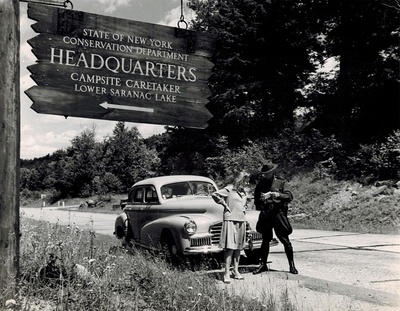 It is not clear what is going on here, but it is clear that this is on New York Route 3 about two miles south-west of the village of Saranac Lake. Lower Saranac Lake Caretaker's Cabin. From a photo album belonging to Conservation Officer Carl Prue, courtesy of Jack Drury.
It is not clear what is going on here, but it is clear that this is on New York Route 3 about two miles south-west of the village of Saranac Lake. Lower Saranac Lake Caretaker's Cabin. From a photo album belonging to Conservation Officer Carl Prue, courtesy of Jack Drury.
Historic Saranac Lake collection. Sources
- Jamieson, Paul and Morris, Donald, Adirondack Canoe Waters, North Flow, Lake George, NY: Adirondack Mountain Club, 1987. ISBN 0-935272-43-7.
- Tolles, Bryant F., Jr., Resort Hotels of the Adirondacks, Lebanon NH: University Press of New England, 2003. ISBN 1-58465-096-6.
External links
- New York State DEC - Camping Information
- ''New York Times'', "Indians' Star lake.; Lower Saranac Keeps Up its Traditions.", June 17, 1906.
Footnotes
1. Historic Saranac Lake
2. James Schlett, 6/22/2008, ''DailyGazette.com'', "Return to the Philosophers’ Camp"
3. Brown, Phil (ed). 2006. Bob Marshall in the Adirondacks. Saranac Lake, New York: Lost Pond Press. ISBN 0978925408.
4. Historic Saranac Lake
5. Taylor, Robert, America's Magic Mountain, Boston: Houghton Mifflin, 1986. ISBN 0-395-37905-9
6. This section of the article appeared originally on "Wikipedia" as Lower Saranac Lake; its edit history there reflects its authorship. It is licensed under the GDFL.
7. Presumably this means what is now called an Air Boat, i.e., it is driven by an airplane propeller.



